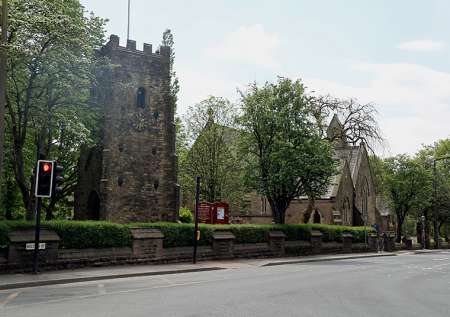Church of St Maxentius, Bolton Road, Bradshaw, near Bolton
BRADSHAW - For the erection of a new church, to be built at Bradshaw, near Bolton. Plans and specifications at the Counting-house, Firwood Works, Bradshaw, or at the office of the architect, Mr. E. G. Paley, Lancaster, to Wednesday, July 29. Tenders to be sent to Mr. Paley on or before Friday, July 31. [Building News 17 July 1863 page 560, Building News 24 July 1863 page 580]
The village of Bradshaw lies some two miles north-east of Bolton on the southern edge of the West Pennine Moors within the parish of Bolton, at an important road junction. During the nineteenth century it developed as an industrial settlement, specialising in bleaching and dyeing. The church, originally built as a chapel of ease, is dedicated to St Maxentius - a French abbot who lived in the small town of St Maixent near Poitiers – and is the only church in England with this dedication. Its construction was slow, starting in 1863, and not being completed until 1872. The old building was by this time very dilapidated and too small for the increasing population. An appeal for funds for a new church had gone out as early as 1846 and by 1859 £2,014 had been promised. The foundations were laid in 1863, at which point all building work ceased. Only when Thomas Hardcastle succeeded to his father’s property was the scheme re-started. It cost £4,300, at least half of which, was given by Thomas Hardcastle. Cruciform in plan, the church was designed in the Geometric Decorated style, and consists of a long nave with a hammer-beam roof, transepts, chancel, south porch and vestry. The stained glass includes two windows by Shrigley and Hunt. The glass in the east window dates from 1896 and was probably designed by Carl Almquist. At the west end is a bell-cote. It was consecrated on 9 November 1872 by James Fraser, Bishop of Manchester. As at Ringley (qv), the mediaeval tower of the old church was retained as a free-standing monument in the churchyard.
St Maxentius was born in AD 448 in a small town called Agatus, near Narbonne on the southern coast of France. Adjutor, as he was then known, attended the local monastery school where he was greatly influenced and encouraged by the teaching philosophy of the Abbot, Severus, a scholar of some renown. So much so that he later entered the monastery of Poitou under the assumed name of Maxentius. where he quickly earned the respect of those about him and soon was appointed Abbot. There are many stories about him, including one of birds eating from his hands (in the manner of St Francis); of he found a well during a very long drought and saved the people of the town nearby; and how he saved the monastery from King Clovis's soldiers, who had come to plunder it. He died on 26 June 515. and lies in the crypt of the parish church in the ancient town of St Maixent, some 34 miles from Poitiers. How the name of St Maxentius came to Bradshaw in Lancashire we shall probably never know, but it is possible that, some soldiers from this village were stationed at St Maixent when Poitou belonged to the English crown between 1154 and 1372. Whatever the reason, Bradshaw is only church in England with such a dedication and, as far as we can ascertain, the little town in Poitou is the only other place where he is remembered. — David M Dunn, Vicar of Bradshaw, Bolton. Lancs.[Manchester Guardian 20 December 1992 page 23]
Reference Manchester Guardian 11 July 1863 Page 2 (Contracts)
Reference Manchester Guardian 17 July 1863 Page 2 (Contracts)
Reference Building News 17 July 1863 page 560, Building News 24 July 1863 page 580 – contracts
Reference Guardian 20 December 1992 page 23
